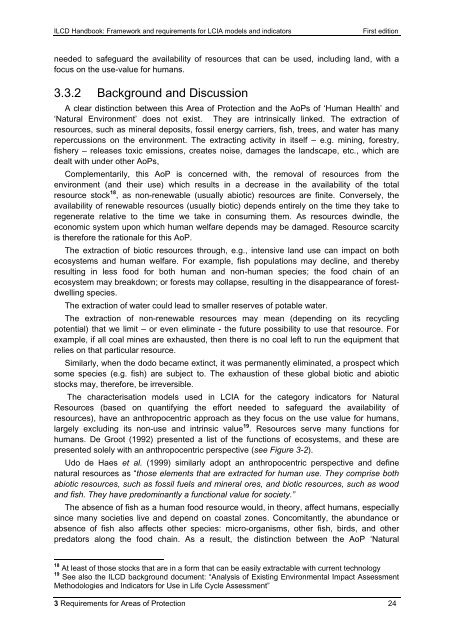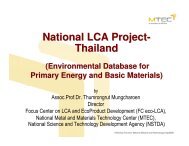ILCD Handbook: Framework and requirements for LCIA models and ...
ILCD Handbook: Framework and requirements for LCIA models and ...
ILCD Handbook: Framework and requirements for LCIA models and ...
You also want an ePaper? Increase the reach of your titles
YUMPU automatically turns print PDFs into web optimized ePapers that Google loves.
<strong>ILCD</strong> <strong>H<strong>and</strong>book</strong>: <strong>Framework</strong> <strong>and</strong> <strong>requirements</strong> <strong>for</strong> <strong>LCIA</strong> <strong>models</strong> <strong>and</strong> indicators First edition<br />
needed to safeguard the availability of resources that can be used, including l<strong>and</strong>, with a<br />
focus on the use-value <strong>for</strong> humans.<br />
3.3.2 Background <strong>and</strong> Discussion<br />
A clear distinction between this Area of Protection <strong>and</strong> the AoPs of ‗Human Health‘ <strong>and</strong><br />
‗Natural Environment‘ does not exist. They are intrinsically linked. The extraction of<br />
resources, such as mineral deposits, fossil energy carriers, fish, trees, <strong>and</strong> water has many<br />
repercussions on the environment. The extracting activity in itself – e.g. mining, <strong>for</strong>estry,<br />
fishery – releases toxic emissions, creates noise, damages the l<strong>and</strong>scape, etc., which are<br />
dealt with under other AoPs,<br />
Complementarily, this AoP is concerned with, the removal of resources from the<br />
environment (<strong>and</strong> their use) which results in a decrease in the availability of the total<br />
resource stock 18 , as non-renewable (usually abiotic) resources are finite. Conversely, the<br />
availability of renewable resources (usually biotic) depends entirely on the time they take to<br />
regenerate relative to the time we take in consuming them. As resources dwindle, the<br />
economic system upon which human welfare depends may be damaged. Resource scarcity<br />
is there<strong>for</strong>e the rationale <strong>for</strong> this AoP.<br />
The extraction of biotic resources through, e.g., intensive l<strong>and</strong> use can impact on both<br />
ecosystems <strong>and</strong> human welfare. For example, fish populations may decline, <strong>and</strong> thereby<br />
resulting in less food <strong>for</strong> both human <strong>and</strong> non-human species; the food chain of an<br />
ecosystem may breakdown; or <strong>for</strong>ests may collapse, resulting in the disappearance of <strong>for</strong>estdwelling<br />
species.<br />
The extraction of water could lead to smaller reserves of potable water.<br />
The extraction of non-renewable resources may mean (depending on its recycling<br />
potential) that we limit – or even eliminate - the future possibility to use that resource. For<br />
example, if all coal mines are exhausted, then there is no coal left to run the equipment that<br />
relies on that particular resource.<br />
Similarly, when the dodo became extinct, it was permanently eliminated, a prospect which<br />
some species (e.g. fish) are subject to. The exhaustion of these global biotic <strong>and</strong> abiotic<br />
stocks may, there<strong>for</strong>e, be irreversible.<br />
The characterisation <strong>models</strong> used in <strong>LCIA</strong> <strong>for</strong> the category indicators <strong>for</strong> Natural<br />
Resources (based on quantifying the ef<strong>for</strong>t needed to safeguard the availability of<br />
resources), have an anthropocentric approach as they focus on the use value <strong>for</strong> humans,<br />
largely excluding its non-use <strong>and</strong> intrinsic value 19 . Resources serve many functions <strong>for</strong><br />
humans. De Groot (1992) presented a list of the functions of ecosystems, <strong>and</strong> these are<br />
presented solely with an anthropocentric perspective (see Figure 3-2).<br />
Udo de Haes et al. (1999) similarly adopt an anthropocentric perspective <strong>and</strong> define<br />
natural resources as ―those elements that are extracted <strong>for</strong> human use. They comprise both<br />
abiotic resources, such as fossil fuels <strong>and</strong> mineral ores, <strong>and</strong> biotic resources, such as wood<br />
<strong>and</strong> fish. They have predominantly a functional value <strong>for</strong> society.”<br />
The absence of fish as a human food resource would, in theory, affect humans, especially<br />
since many societies live <strong>and</strong> depend on coastal zones. Concomitantly, the abundance or<br />
absence of fish also affects other species: micro-organisms, other fish, birds, <strong>and</strong> other<br />
predators along the food chain. As a result, the distinction between the AoP ‗Natural<br />
18 At least of those stocks that are in a <strong>for</strong>m that can be easily extractable with current technology<br />
19 See also the <strong>ILCD</strong> background document: ―Analysis of Existing Environmental Impact Assessment<br />
Methodologies <strong>and</strong> Indicators <strong>for</strong> Use in Life Cycle Assessment‖<br />
3 Requirements <strong>for</strong> Areas of Protection 24



